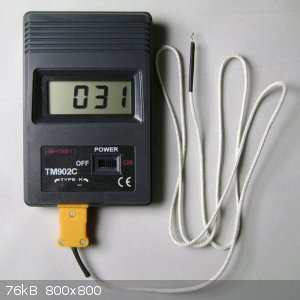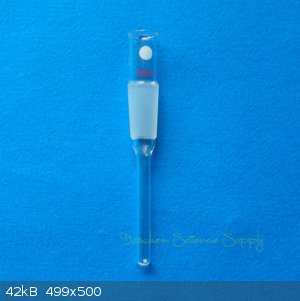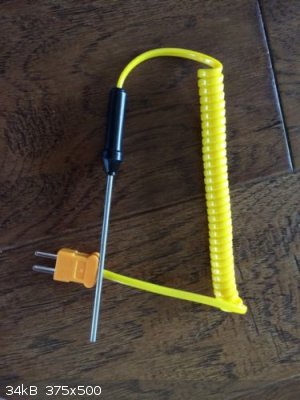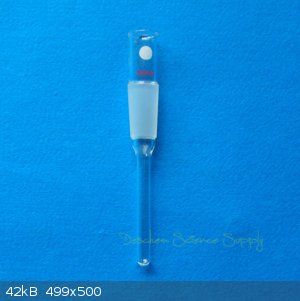| Pages:
1
2
3 |
Db33
Hazard to Others
  
Posts: 206
Registered: 25-11-2016
Member Is Offline
Mood: No Mood
|
|
Proper Use of Thermocouple
i bought this on ebay because i saw Nurdrage or someone on youtube using one. Its a thermometer probe. Am i correct in assuming that i can use this in
place of a normal thermometer for distillations and stuff by putting it in the thermometer adapter on top of the condenser? I think Nurdrage covered
the end of his probe with a piece of glass from a pipette or something, should i do that? Any other tips or hints i REALLY appreciate because i am
very new to this stuff. Thank u.

Edit: Gave thread a descriptive title
[Edited on 12-13-2016 by zts16]
|
|
|
diddi
National Hazard
   
Posts: 723
Registered: 23-9-2014
Location: Victoria, Australia
Member Is Offline
Mood: Fluorescent
|
|
the thermocouple metals may be attacked by your distilate so YES always protect with glass. ensure that the thermocouple is is direct contact with
the glass (you could consider using silver thermal paste) also make sure you seal the top of your glass tube
Beginning construction of periodic table display
|
|
|
PeterC
Harmless

Posts: 23
Registered: 11-12-2016
Member Is Offline
Mood: No Mood
|
|
You can either put the thermocouple into a sealed pasteur pipette (preferably one that fits your apparatus) or buy a thermometer shield like this: https://www.aliexpress.com/popular/ground-thermometer.html
|
|
|
Db33
Hazard to Others
  
Posts: 206
Registered: 25-11-2016
Member Is Offline
Mood: No Mood
|
|
so the tip of the thermocouple always has to actually touch the glass? is that hard to do?
|
|
|
PeterC
Harmless

Posts: 23
Registered: 11-12-2016
Member Is Offline
Mood: No Mood
|
|
For best result it should so I would either tape it to the glass or cheat and use some thermal transfer paste + tape (won't be too accurate but should
hypothetically work).
|
|
|
DJF90
International Hazard
    
Posts: 2266
Registered: 15-12-2007
Location: At the bench
Member Is Offline
Mood: No Mood
|
|
I've always used a small amount of silicone oil as a heat transfer medium in thermocouple wells.
For GMP manufacture, the solvent used in the reaction is also used as a heat transfer medium in the thermocouple well to minimise/eliminate the
potential for contamination with silicone oil in the event of a breakage.
|
|
|
Db33
Hazard to Others
  
Posts: 206
Registered: 25-11-2016
Member Is Offline
Mood: No Mood
|
|
Quote: Originally posted by DJF90  | I've always used a small amount of silicone oil as a heat transfer medium in thermocouple wells.
For GMP manufacture, the solvent used in the reaction is also used as a heat transfer medium in the thermocouple well to minimise/eliminate the
potential for contamination with silicone oil in the event of a breakage. |
so you pour some silicon oil in the glass tubewith the thermocouple?
|
|
|
Sulaiman
International Hazard
    
Posts: 3558
Registered: 8-2-2015
Location: 3rd rock from the sun
Member Is Offline
|
|
Read but not tried
Sn : Pb, 63 : 37 solder melts at c183 C
Sn melts at c232 C
Pb c327 C
so can be used to embed thermocouples in glass tubes.
[Edited on 13-12-2016 by Sulaiman]
CAUTION : Hobby Chemist, not Professional or even Amateur
|
|
|
careysub
International Hazard
    
Posts: 1339
Registered: 4-8-2014
Location: Coastal Sage Scrub Biome
Member Is Offline
Mood: Lowest quantum state
|
|
Quote: Originally posted by PeterC  | | For best result it should so I would either tape it to the glass or cheat and use some thermal transfer paste + tape (won't be too accurate but should
hypothetically work). |
I challenge the claim that this would impair accuracy in some way. Are you thinking perhaps that it is a bare thermocouple junction? If so then I
would agree, and indeed insist that only chromel-inert insulating liquids be considered.
Otherwise, why would that be? At worst any arrangement would simply slow the heat transfer and cause a lag in response in achieving thermal
equilibrium. The purpose of the thermal paste is to speed up the transfer and thus improve the response time.
Accuracy should be unaffected. Thermal equilibrium is thermal equilibrium.
[Edited on 13-12-2016 by careysub]
[Edited on 13-12-2016 by careysub]
About that which we cannot speak, we must remain silent.
-Wittgenstein
Some things can never be spoken
Some things cannot be pronounced
That word does not exist in any language
It will never be uttered by a human mouth
- The Talking Heads
|
|
|
careysub
International Hazard
    
Posts: 1339
Registered: 4-8-2014
Location: Coastal Sage Scrub Biome
Member Is Offline
Mood: Lowest quantum state
|
|
Quote: Originally posted by Sulaiman  | Read but not tried
Sn : Pb, 63 : 37 solder melts at c183 C
Sn melts at c232 C
Pb c327 C
so can be used to embed thermocouples in glass tubes.
[Edited on 13-12-2016 by Sulaiman] |
And then there is Wood's Alloy, mp 70 C. It contains cadmium, but this is a tiny amount in a sealed glass tube (or that matter, pure gallium or
indium, or galinstan, or mercury).
One thing to keep in mind when considering an electrically conductive (and a metallic) thermal coupling agent is how the thermocouple is packaged. If
a metal comes in contact with the thermocouple junction then its sensing properties are probably ruined.
If you have a bare thermocouple stick with silicone oil or other insulating liquid of high BP which won't react with the chromel alloy.
If it is in a stainless steel jacket then anything should be OK.
About that which we cannot speak, we must remain silent.
-Wittgenstein
Some things can never be spoken
Some things cannot be pronounced
That word does not exist in any language
It will never be uttered by a human mouth
- The Talking Heads
|
|
|
Fulmen
International Hazard
    
Posts: 1693
Registered: 24-9-2005
Member Is Offline
Mood: Bored
|
|
Alloys containing bismuth, like Woods, Cerrosafe, Cerroshield and similar tend to expand on (and for sometime after) solidification. I tried casting
Cerroshield (Bi/Pb/Sn) in a thick walled test tube once, and it broke appr 30 seconds after solidification.
| Quote: | | If a metal comes in contact with the thermocouple junction then its sensing properties are probably ruined. |
You'd think so, but solder is fine. At my old job we routinely made K-elements from wire, they were simply twisted together and soldered with regular
lead/tin solder. Worked perfectly every time.
We're not banging rocks together here. We know how to put a man back together.
|
|
|
Sulaiman
International Hazard
    
Posts: 3558
Registered: 8-2-2015
Location: 3rd rock from the sun
Member Is Offline
|
|
in theory I disagree,
it should be possible to have any number of metals mixed/joined/alloyed
and the thermocouple reading should be accutate -
provided that all are at the same temperature.
https://en.wikipedia.org/wiki/Thermoelectric_effect
CAUTION : Hobby Chemist, not Professional or even Amateur
|
|
|
DJF90
International Hazard
    
Posts: 2266
Registered: 15-12-2007
Location: At the bench
Member Is Offline
Mood: No Mood
|
|
Yep. More oil means more thermal mass which means slower response to change in temperature, so just use a small amount (about a centimetre depth).
|
|
|
careysub
International Hazard
    
Posts: 1339
Registered: 4-8-2014
Location: Coastal Sage Scrub Biome
Member Is Offline
Mood: Lowest quantum state
|
|
OK then - mercury or galinstan would be good to go, as well as silver thermal paste. Nothing that solidifies.
About that which we cannot speak, we must remain silent.
-Wittgenstein
Some things can never be spoken
Some things cannot be pronounced
That word does not exist in any language
It will never be uttered by a human mouth
- The Talking Heads
|
|
|
unionised
International Hazard
    
Posts: 5102
Registered: 1-11-2003
Location: UK
Member Is Offline
Mood: No Mood
|
|
Cooking oil as a heat transfer medium, anyone?
|
|
|
DJF90
International Hazard
    
Posts: 2266
Registered: 15-12-2007
Location: At the bench
Member Is Offline
Mood: No Mood
|
|
That'd work equally well too. I mentioned silicone oil because thats what is usually found in the lab...
|
|
|
Db33
Hazard to Others
  
Posts: 206
Registered: 25-11-2016
Member Is Offline
Mood: No Mood
|
|
i recieved it today in the mail and there is a weird issue, if you look in the photo at the very end of the wire is 2 tiny wires poking out. When i
received it it has these 2 little wires that are hanging out about 1cm out but there is a ball on the end, some kind of glue to keep them together?
its silver. Anyways do i just put this in the bottom of something like this
 and that will take the temp of the distillation? and that will take the temp of the distillation?
|
|
|
Db33
Hazard to Others
  
Posts: 206
Registered: 25-11-2016
Member Is Offline
Mood: No Mood
|
|
or could i use this instead?

|
|
|
alking
Hazard to Others
  
Posts: 252
Registered: 11-3-2016
Member Is Offline
Mood: No Mood
|
|
I use a probe like that pictured and do not jacket it or anything, but then I only use it where metals are non reactive. For other things I use a
glass thermometer. I'd love to be able to use it all the time as it's much more accurate. In your 2nd to last pic I have no idea what you're talking
about though, there's nothing but glass in that picture, no wires.
|
|
|
XeonTheMGPony
International Hazard
    
Posts: 1636
Registered: 5-1-2016
Member Is Offline
Mood: No Mood
|
|
selection is very important as Thermal couples can be a degree or so off, better gear will be more accurate, but the cheaper chines stuff so be aware
of that.
Mercury can not be used with the thermal couples as it will short it out, they are a voltage source, so any thing conductive will cause it to read
grossly inaccurate.
So use care full selection on the temp ranges, do not use it for things that will require careful accuracy less it is a higher quality unit with a
narrow range thermal couple.
So as said must be in a sealed cell like the one you have, use a drip of white thermal grease, or arctic silver Ceramique (http://www.newegg.ca/Product/Product.aspx?Item=N82E168351000...) as it is not conductive with low inductive qualities.
|
|
|
WGTR
National Hazard
   
Posts: 971
Registered: 29-9-2013
Location: Online
Member Is Offline
Mood: Outline
|
|
Quote: Originally posted by XeonTheMGPony  | | Mercury can not be used with the thermal couples as it will short it out, they are a voltage source, so any thing conductive will cause it to read
grossly inaccurate. |
I wouldn't use mercury, but not for the reason stated. Mercury alloys with a lot of things, and might not be compatible with a particular
thermocouple's metals. Same with any molten metal system. Molten solder gradually dissolves copper, for example.
I understand your reasoning, but I'm not sure that electrical conductivity is a factor like you think it is. It should be possible to bridge the two
thermocouple wires together with a third metal, so long as both junction areas remains the same temperature.
|
|
|
Db33
Hazard to Others
  
Posts: 206
Registered: 25-11-2016
Member Is Offline
Mood: No Mood
|
|
would the probe, the long metal one, if it was put inside a tube like this, would it read the internal temp correctly threw the glass?

|
|
|
WGTR
National Hazard
   
Posts: 971
Registered: 29-9-2013
Location: Online
Member Is Offline
Mood: Outline
|
|
Quote: Originally posted by Db33  | would the probe, the long metal one, if it was put inside a tube like this, would it read the internal temp correctly threw the glass?
|
It would if the thermal conductivity along the length of the probe is negligible compared to that through the glass to the probe junction. Air has
poor thermal conductivity, so minimizing the air path with heat sink compound, solder, etc., helps greatly.
A lot of probes are designed with stainless steel jackets, as this metal has low thermal conductivity, relative to something like copper.
|
|
|
Melgar
Anti-Spam Agent
    
Posts: 2004
Registered: 23-2-2010
Location: Connecticut
Member Is Offline
Mood: Estrified
|
|
I'm planning on putting a stainless steel probe inside of a glass tube to use as a thermometer. If it's a snug fit, would I have to worry about
different coefficients of thermal expansion cracking the glass? I know stainless steel is almost certainly higher than borosilicate glass, but with a
5 mm diameter probe, the differences could be negligible for the 20-200C range.
|
|
|
XeonTheMGPony
International Hazard
    
Posts: 1636
Registered: 5-1-2016
Member Is Offline
Mood: No Mood
|
|
I will read correctly but there will be a larger lag time from reaction temp to reading due to the mass, so if you need to monitor fast temps this
will not be a good system, but for slow temp changes this will be fine.
Some thing to keep in mind. Now if I where to do that I would dope the tipe with thermal grease then use a spacer such as a o-ring or some care fully
wound paper at the top to use the air as an insulator, the actual junction will be closest to the tip of the probe.
@ WGTR: Being this is morning and first cup of coffe still. I may be in error, but I do not think so, thermal cupels can be shorted
out. They are essentially a potential generator, you are reading the voltage that they generate then mapping the voltage to the temperature table. Any
thing that can interfere with the voltage signal will adulterate the temp readings.
I can care fully tack solder the ball to a pipe (HVAC in this case) to measure the fine temp changes accurately, but any thing going to the outlet
wires will short the generator out and cause a failed reading.
Alloying is the lesser issue to the fact mercury can coat the ball and short out the signal, as will conductive thermal greases
|
|
|
| Pages:
1
2
3 |